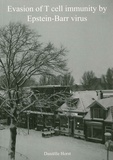Evasion of T cell immunicty by Epstein-Barr virus

Horst, Daniëlle
- Promoter:
- Prof.dr. E.J.H.J. (Emmanuel) Wiertz
- Co-promoter:
- Dr M.E. (Maaike) Ressing
- Research group:
- Wiertz
- Date:
- October 14, 2011
- Time:
- 10:30 h
Summary
Immune evasion strategies are thought to contribute essentially to the life cycle of persistent viruses by delaying the elimination of the infected cell long enough to enable the virus to replicate. Exemplary in this context are the herpesviruses, large DNA viruses that are carried as a persistent and largely asymptomatic infection by the vast majority of adults. Epstein-Barr virus (EBV), the prototypic gamma-herpesvirus, is the causative agent of infectious mononucleosis and of post-transplant lymphoproliferative disorders and is associated with Burkitt’s lymphoma, nasopharyngeal carcinoma, and Hodgkin’s lymphoma. EBV-specific immune responses are present in infected individuals, yet the virus cannot be cleared. EBV resides in B cells, mostly in a latent state with limited viral gene expression. In contrast, over eighty viral proteins are expressed during the replicative phase that is required for virus production and transmission to other hosts. At this stage,immune evasion strategies are important to avoidelimination of virus-producing cells. This thesis describes the identification and characterization of a new and very powerful EBV-encoded immune evasion protein, the TAP inhibitor BNLF2a. Furthermore, it was investigated how BGLF5, another recently discovered EBV immune evasion protein, blocks host protein synthesis. During productive EBV infection, the immune evasion protein BNLF2a inhibits transport of antigenic peptides into the ER via the Transporter associated with Antigen Processing (TAP). As a consequence, antigen presentation via HLA class I molecules is impaired and T cell recognition is avoided. In virus-producing B cells, the timing of BNLF2a expression allows for immediate interference with the presentation of viral antigens by HLA class I molecules. BNLF2a is highly expressed early upon EBV reactivation and declines during progression of viral replication. BNLF2a displays characteristics of a tail-anchored (TA) protein: we find the viral protein to be inserted into membranes post-translationally, with its hydrophobic C-terminal domain functioning as a membrane anchor. This topology leaves BNLF2a’s N-terminal domain exposed in the cytosol, where it inhibits TAP function. Expression of the EBV lytic phase protein BGLF5 results in a general block in the synthesis of cellular proteins, including HLA class I molecules. This host shutoff activity of BGLF5 relies on its ability to induce degradation of mRNA. Originally, BGLF5 was identified as a DNase, being involved in viral replication. More recently, BGLF5 was demonstrated to have RNase activity as well. When analysing various mutants of BGLF5, we found, on the one hand, that a point mutation destroying DNase function also blocked RNase activity, implying both nuclease activities to share a catalytic site. On the other hand, other mutations were more selective affecting either DNA degradation or host shutoff, pointing towards separation of these two functions. In conclusion, the EBV lytic phase proteins BNLF2a and BGLF5 contribute to the obstruction of HLA class I-restricted antigen presentation to cytotoxic T cells. Interference with T cell recognition during productive EBV infection is anticipated to create a window for the generation of viral progeny in the face of memory T cell immunity.